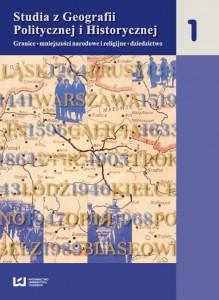Spatial differentiation of assimilation processes of Polish community in New York City
DOI:
https://doi.org/10.18778/2300-0562.01.12Keywords:
Polonia, assimilation, naturalization, New York CityAbstract
The paper aims the analysis of assimilation processes of Polish community in New York City. In order to study this complex problem it is necessary to characterize selected factors influencing the pace of assimilation and its differentiation in New York's group of Polish descent. The article presents an origins and development of Polish and Polish-American community as well as its current spatial concentration (residential pattern) and total population in the city. The research also includes naturalization processes associated with taking U.S. citizenship, activities of Polish institutions and organizations and use of native language by group of Polish descent as well as the cultivation of native traditions.
The first Poles immigrated from Poland in the seventeenth century to the Dutch colony, at that time – the New Netherlands and to New Amsterdam as the center of the province. However, the biggest wave of immigration from the Polish lands was related to the socio – economic intense inflow at the turn of twentieth century.
Currently, New York's Polish community is made up of various waves of immigrations. However, the most significant group of Polish immigrants is that from the last two decades. Thus, Polish community in New York can be defined as a relatively young, which mainly emigrated from Poland in the nineties last century.
According to the 2009 American Community Survey , there is about 243,000 people of Polish descent in New York. This group includes both Polish Americans (people born with American citizenship in the United States), as well as Polish immigrants with Polish or American citizenship. Most people with Polish ancestry live in Brooklyn neighborhoods (Greenpoint, Williamsburg, Borough Park, Park Slope, Midwood). The Queens community of Polish descent is mostly located in Rigdewood, Maspeth, Middle Village, Bayside, Bellerose, Floral Park. In Manhattan, Polish community is more dispersed and people with Polish ancestry live mainly in East Village, the Upper West Side and Yorkville (so-called Little Poland).
Based on the residential patterns of the Polish community in New York and the spatial concentration of various ethnic organizations and institutions (churches, Sunday schools, associations, institutions, foundations, etc.) the author identifies four areas that are characterized by high population density of the Polish ethnic group as well as the presence of a number of Polish institutions. There are two areas in Brooklyn borough – Greenpoint / Williamsburg, Park Slope and one in Queens – Ridgewood / Maspeth and Manhattan – East Village.
Along with decreasing influx of Polish immigrants and their movements into new communities (spatial dispersion) it can be expected to intensify the processes of assimilation in this group. In addition, it can be observed that the number of naturalized persons is gradually increasing. Another indicator of assimilation advancement might be the attainment of English-proficiency. The greater the level of English-language skills, the higher the chance for educational and employment achievement. A large part of the Polish community in New York (64% of this group) uses only English. Polish language is used mainly by generations of immigrants living primarily in Brooklyn (Greenpoint) and Queens borough (Ridgewood).
Among different Polish organizations and institutions the most important is Polish parish and church which cares for the traditional customs, celebrating Polish Christmas and other holidays. Many Polish parishes in New York City also formed schools (called Sunday schools) which are an important factor in delaying the processes of assimilation.
References
Bonusiak A., 2004, Szkolnictwo polskie w Stanach Zjednoczonych Ameryki w latach 1984–2003: analiza funkcjonalno-instytucjonalna, Wydawnictwo Uniwersytetu Rzeszowskiego, Rzeszów.
Google Scholar
Czerwińska M., 2007, Inkulturacyjna rola parafii polonijnej w USA na przykładzie wybranych parafii z Chicago, Detroit i Nowego Jorku (1867–1976), „Studia Polonijne”, 28, s. 243–271.
Google Scholar
Drąg Korga I., 2010, Polskie instytucje w Nowym Jorku. Historia i współczesność, [w:] D. Piątkowska (red.), Polonijny Nowy Jork, Instytut Józefa Piłsudskiego, Nowy Jork–Opole.
Google Scholar
Drozdowski M., 1979, Problemy dziejów Polonii, PWN, Warszawa.
Google Scholar
Drzewieniecki W., 1979, Polonia amerykańska w perspektywie historycznej, [w:] Drozdowski M. (red.), Problemy dziejów Polonii, PWN, Warszawa.
Google Scholar
Frančić M., 1988, Emigracja z Polski do Stanów Zjednoczonych Ameryki od roku 1918 do lat siedemdziesiątych XX w., [w:] Polonia amerykańska. Przeszłość i współczesność, Zakład Narodowy Ossolińskich, Wydawnictwo PAN, Wrocław.
Google Scholar
Frysztacki K., 1986, Polonia w dużym mieście amerykańskim. Studium przemian podspołeczności polonijnej w Buffalo, Zakład Narodowy im. Ossolińskich, Wrocław.
Google Scholar
Leś B., 1981, Kościół w procesie asymilacji Polonii amerykańskiej: przemiany funkcji polonijnych instytucji i organizacji religijnych w środowisku Polonii chicagowskiej, Zakład Narodowy imienia Ossolińskich, Wrocław.
Google Scholar
Piątkowska D., 2002, Polskie kościoły w Nowym Jorku, Nowy Jork–Opole.
Google Scholar
Roszkowski W., 2007, Historia Polski 1914–1991, PWN, Warszawa.
Google Scholar
Taras P., 1989, Polonia w Detroit: problem kulturowej tożsamości i społecznego awansu: socjologiczne studium społeczności etnicznej w USA, Pallottinum, Warszawa.
Google Scholar
Tomalka A., 2011, Procesy asymilacji i standard życia Polonii nowojorskiej, praca magisterska napisana w Katedrze Geografii Politycznej i Studiów Regionalnych UŁ, promotor: M. Sobczyński, Łódź.
Google Scholar
Walaszek A., 1979, Między Nowym Jorkiem a Gdańskiem. Reemigracja ze Stanów Zjednoczonych i Kanady do Polski w latach 1919–1923, „Przegląd Polonijny”, 3, s. 21–39.
Google Scholar
Walaszek A., 1994, Światy imigrantów: tworzenie polonijnego Cleveland: 1880–1930, Nomos, Kraków.
Google Scholar
Walaszek A., 2008, Polonia amerykańska, [w:] Płudowski T. (red.), Ameryka – Społeczeństwo, t. 1, Wydawnictwo Adam Marszałek, Toruń, s. 219–250.
Google Scholar
Zych A., 2005, The Living Situation of Elderly Americans of Polish Descent in Chicago, Wydawnictwo Naukowe Dolnośląskiej Szkoły Wyższej Edukacji TWP, Wrocław.
Google Scholar
Downloads
Published
How to Cite
Issue
Section
License

This work is licensed under a Creative Commons Attribution-NonCommercial-NoDerivatives 4.0 International License.








